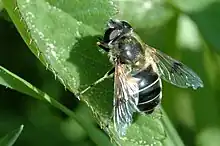Eristalis rupium
Eristalis rupium, commonly known as the spot-winged drone fly, is a species of syrphid fly that was first described by Fabricius in 1805. It is a common European species, and uncommon in North America. Hoverflies get their names from the ability to remain nearly motionless while in flight. The adults are also known as flower flies as they are commonly found around and on flowers, from which they get both energy-giving nectar and protein-rich pollen. The larvae are aquatic filter-feeders of the rat-tailed type, found in streams with clear water.[1][2][3]
.jpg.webp)
Eristalis rupium
| Eristalis rupium | |
|---|---|
 | |
| Eristalis rupium female | |
| Scientific classification | |
| Domain: | Eukaryota |
| Kingdom: | Animalia |
| Phylum: | Arthropoda |
| Class: | Insecta |
| Order: | Diptera |
| Family: | Syrphidae |
| Genus: | Eristalis |
| Species: | E. rupium |
| Binomial name | |
| Eristalis rupium Fabricius, 1805 | |
| Synonyms | |
| |
References
- Speight, M.C.D. (2011) Species accounts of European Syrphidae (Diptera), Glasgow2011. Syrph the Net, the database of European Syrphidae, vol. 65, 285 pp., Syrph the Net publications, Dublin.
- Van Veen, M.P. (2004). Hoverflies of Northwest Europe, Identification Keys to the Syrphidae (Hardback). Utrecht: KNNV Publishing. p. 254. ISBN 90-5011-199-8.
- Stubbs, Alan E.; Falk, Steven J. (1983). British Hoverflies: An Illustrated Identification Guide. British Entomological & Natural History Society. p. 253, xvpp.
This article is issued from Wikipedia. The text is licensed under Creative Commons - Attribution - Sharealike. Additional terms may apply for the media files.